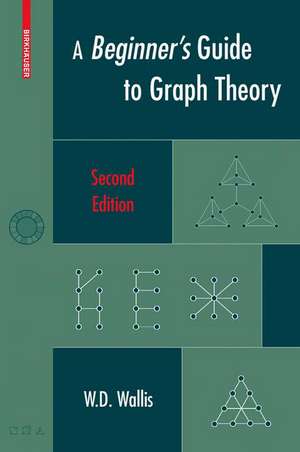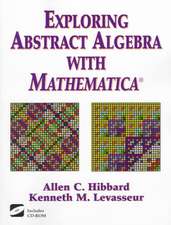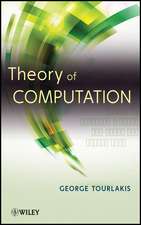A Beginner's Guide to Graph Theory
Autor W.D. Wallisen Limba Engleză Paperback – 8 iun 2007
This second edition includes new chapters on labeling and communications networks and small-worlds, as well as expanded beginner's material in the early chapters, including more examples, exercises, hints and solutions to key problems. Many additional changes, improvements, and corrections resulting from classroom use and feedback have been added throughout. With a distinctly applied flavor, this gentle introduction to graph theory consists of carefully chosen topics to develop graph-theoretic reasoning for a mixed audience. Familiarity with the basic concepts of set theory, along with some background in matrices and algebra, and a little mathematical maturity are the only prerequisites.
Preț: 420.20 lei
Nou
Puncte Express: 630
Preț estimativ în valută:
80.42€ • 83.64$ • 66.39£
80.42€ • 83.64$ • 66.39£
Carte tipărită la comandă
Livrare economică 14-28 aprilie
Preluare comenzi: 021 569.72.76
Specificații
ISBN-13: 9780817644840
ISBN-10: 0817644849
Pagini: 260
Ilustrații: XX, 260 p. 160 illus.
Dimensiuni: 155 x 235 x 13 mm
Greutate: 0.39 kg
Ediția:2nd ed. 2007
Editura: Birkhäuser Boston
Colecția Birkhäuser
Locul publicării:Boston, MA, United States
ISBN-10: 0817644849
Pagini: 260
Ilustrații: XX, 260 p. 160 illus.
Dimensiuni: 155 x 235 x 13 mm
Greutate: 0.39 kg
Ediția:2nd ed. 2007
Editura: Birkhäuser Boston
Colecția Birkhäuser
Locul publicării:Boston, MA, United States
Public țintă
Lower undergraduateCuprins
Graphs.- Walks, Paths and Cycles.- Connectivity.- Trees.- Linear Spaces Associated with Graphs.- Factorizations.- Graph Colorings.- Planarity.- Labeling.- Ramsey Theory.- Digraphs.- Critical Paths.- Flows in Networks.- Computational Considerations.- Communications Networks and Small-Worlds.
Recenzii
From the reviews:
"Altogether the book gives a comprehensive introduction to graphs, their theory and their application…The use of the text is optimized when the exercises are solved. The obtained skills improve understanding of graph theory as well… It is very useful that the solutions of these exercises are collected in an appendix." (Simulation News Europe)
From the reviews of the second edition:
"This book is a gentle introduction to graph theory, presenting the main ideas and topics … . It is accessible to everyone … . This introductory book is addressed to a mixed audience – undergraduate mathematics majors, computer scientists, engineers … . this book is ideal as well for self-reading. The style is always concise and the essential techniques are well highlighted … . It is highly recommended to any student, or working scientist, wishing to explore for the first time this fascinating area of mathematics." (Fabio Mainardi, The Mathematical Association of America, August, 2009)
“This book is intended as an introductory course in Graph Theory, one of the fastest growing disciplines of modern Mathematics. … The book is nicely written, the presentation is comprehensible but at the same time mathematically precise. The text is supplemented with many figures, with historical notes to many topics and with many examples. … Summarizing, this is a nice book, useful not only as an introductory reading for ‘beginners’ in Graph Theory, but also for those who teach introductory courses in Graph Theory.” (Zdeněk Ryjáček, Mathematica Bohemica, Issue 2, 2010)
"Altogether the book gives a comprehensive introduction to graphs, their theory and their application…The use of the text is optimized when the exercises are solved. The obtained skills improve understanding of graph theory as well… It is very useful that the solutions of these exercises are collected in an appendix." (Simulation News Europe)
From the reviews of the second edition:
"This book is a gentle introduction to graph theory, presenting the main ideas and topics … . It is accessible to everyone … . This introductory book is addressed to a mixed audience – undergraduate mathematics majors, computer scientists, engineers … . this book is ideal as well for self-reading. The style is always concise and the essential techniques are well highlighted … . It is highly recommended to any student, or working scientist, wishing to explore for the first time this fascinating area of mathematics." (Fabio Mainardi, The Mathematical Association of America, August, 2009)
“This book is intended as an introductory course in Graph Theory, one of the fastest growing disciplines of modern Mathematics. … The book is nicely written, the presentation is comprehensible but at the same time mathematically precise. The text is supplemented with many figures, with historical notes to many topics and with many examples. … Summarizing, this is a nice book, useful not only as an introductory reading for ‘beginners’ in Graph Theory, but also for those who teach introductory courses in Graph Theory.” (Zdeněk Ryjáček, Mathematica Bohemica, Issue 2, 2010)
Textul de pe ultima copertă
Graph theory continues to be one of the fastest growing areas of modern mathematics because of its wide applicability in such diverse disciplines as computer science, engineering, chemistry, management science, social science, and resource planning. Graphs arise as mathematical models in these fields, and the theory of graphs provides a spectrum of methods of proof. This concisely written textbook is intended for an introductory course in graph theory for undergraduate mathematics majors or advanced undergraduate and graduate students from the many fields that benefit from graph-theoretic applications.
Key features:
* Introductory chapters present the main ideas and topics in graph theory—walks, paths and cycles, radius, diameter, eccentricity, cuts and connectivity, trees
* Subsequent chapters examine specialized topics and applications
* Numerous examples and illustrations
* Comprehensive index and bibliography, with suggested literature for more advanced material
New to the second edition:
* New chapters on labeling and on communications networks and small-worlds
* Expanded beginner’s material in the early chapters, including more examples, exercises, hints and solutions to key problems
* Many additional changes, improvements, and corrections throughout resulting from classroom use and feedback
Striking a balance between a theoretical and practical approach with a distinctly applied flavor, this gentle introduction to graph theory consists of carefully chosen topics to develop graph-theoretic reasoning for a mixed audience. Familiarity with the basic concepts of set theory, along with some background in matrices and algebra, and a little mathematical maturity are the only prerequisites.
-----
From a review of the first edition:
"Altogether the book gives a comprehensive introduction to graphs, their theoryand their application…The use of the text is optimized when the exercises are solved. The obtained skills improve understanding of graph theory as well… It is very useful that the solutions of these exercises are collected in an appendix."
—Simulation News Europe
Key features:
* Introductory chapters present the main ideas and topics in graph theory—walks, paths and cycles, radius, diameter, eccentricity, cuts and connectivity, trees
* Subsequent chapters examine specialized topics and applications
* Numerous examples and illustrations
* Comprehensive index and bibliography, with suggested literature for more advanced material
New to the second edition:
* New chapters on labeling and on communications networks and small-worlds
* Expanded beginner’s material in the early chapters, including more examples, exercises, hints and solutions to key problems
* Many additional changes, improvements, and corrections throughout resulting from classroom use and feedback
Striking a balance between a theoretical and practical approach with a distinctly applied flavor, this gentle introduction to graph theory consists of carefully chosen topics to develop graph-theoretic reasoning for a mixed audience. Familiarity with the basic concepts of set theory, along with some background in matrices and algebra, and a little mathematical maturity are the only prerequisites.
-----
From a review of the first edition:
"Altogether the book gives a comprehensive introduction to graphs, their theoryand their application…The use of the text is optimized when the exercises are solved. The obtained skills improve understanding of graph theory as well… It is very useful that the solutions of these exercises are collected in an appendix."
—Simulation News Europe
Caracteristici
Concisely written, gentle introduction to graph theory suitable as a textbook or for self-study Graph-theoretic applications from diverse fields (computer science, engineering, chemistry, management science) 2nd ed. includes new chapters on labeling and communications networks and small worlds, as well as expanded beginner's material Many additional changes, improvements, and corrections resulting from classroom use











